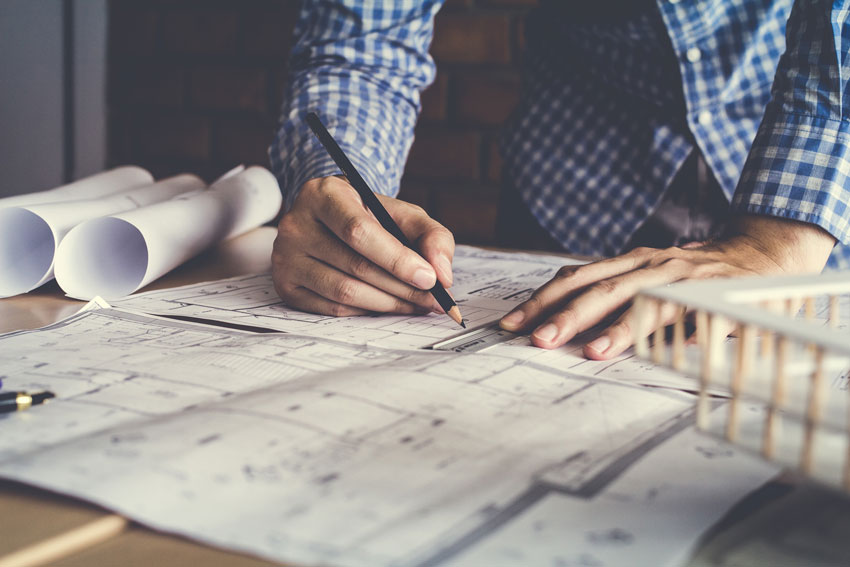Sustainability and the Textile Industry
How Sustainability Impacts the Architect, Builder, Manufacturer, and Occupant
Anyone in the building industry knows that sustainability has shifted over the past decade or two from being a novel approach to almost being the norm, with projects designed to earn LEED credits and with new materials designed to improve the health of the building occupants. Recently, green building has grown considerably, and sustainability is at the core of that movement. Decisions that impact a project’s sustainability are part of every phase, from design to product and material specification, and those decisions can impact many different stakeholders. This section focuses on how sustainable decisions impact the major project stakeholders, including architects, builders, manufacturers, and occupants.
How Sustainability Impacts the Architect and Interior Designer
The sustainability movement has slowly but significantly impacted the profession of architecture. Over the past 10 to 15 years, architecture, a traditionally conservative profession, has become more innovative when it comes to sustainable design. Where older buildings may have been designed and constructed more to meet aesthetic ideals, architects now routinely include sustainability and energy efficiency as design goals.

The drive to design for sustainability impacts the architect both in terms of design goals and project outcomes.
Among other things, this shift toward sustainable architectural design is linked to the impact that this profession can make in energy use. The built environment is extremely energy intensive; in 2016, about 40 percent of total United States energy consumption was from residential and commercial sectors. And this built environment is growing. This growth trend means that architects are now in a position to design more energy-efficient, sustainable, resilient structures.
According to the American Institute of Architects, sustainability is a “key element to the architecture profession’s approach to design in the 21st century as it tackles the compounding global challenges of resource availability, water quality, and increasing pollution. It is part of an architect’s approach to protecting the health, safety, and welfare of the public. Community sustainability goals are fulfilled in large part by an architect’s ability to create practical solutions to the challenges posed by climate change, population growth, and the pursuit of more connected, healthier communities.”6
In short, sustainability impacts the architect both in terms of design goals and project outcomes. New buildings need to take current energy models into account and be constructed with products and materials that improve the overall sustainable elements of the finished project. Moreover, the local environment needs to be considered in the design, whether to improve the community or to plan for future features, such as solar panels or a green roof installation.
How Sustainability Impacts the Builder
As with architecture, the building profession has seen sustainability shift from being a complex set of new requirements over the past couple decades to commonplace construction practice. In fact, most clients, whether individual consumers, developers, or cities, expect that new construction will meet certain minimum sustainability levels. That minimum may be a lot higher in some states, where green building is seen as priority. California, for example, has implemented CAL Green, which is a sustainable building code. This movement has helped make the local construction industry more sustainable than it has ever been.7
For builders, sustainability practices have traditionally focused on making the building more energy efficient and reducing material waste. Practices such as using house wrap and foam spray insulation or custom-cut prefabricated materials have become standard and are helping produce more sustainable buildings.
More recent impacts have been practices that include making sure buildings are healthy places—both for the builders and for the eventual occupants. For example, an increased awareness of the impact of volatile organic compounds (VOCs) has meant that builders now need to focus on things like indoor air quality.
How Sustainability Impacts the Manufacturer
Sustainable manufacturing refers to the practice of processing resources into products with minimal negative impact. These processes may include innovative ways to decrease or prevent greenhouse gases (GHGs), conserve raw natural resources, and minimize energy use. In addition, sustainable manufacturing aims to employ processes and products that are safe for employees, consumers, and communities. In doing so, many industries have found that they made a difference in three key ways: financial benefits, environmental benefits, and increased transparency about materials and product ingredients.8
With green building practices becoming more commonplace—and with their potential to be required by building code, as in California—manufacturers have an incredible opportunity to go above and beyond new building regulations for material sustainability. For example, they can increase operational efficiency and innovate with materials and processes to create superior products that go beyond compliance, often by working with stakeholders such as architects, builders, and consumers. In doing so, there is a huge opportunity for financial benefit and competitive advantage over other companies.9
Durability is returning as a key characteristic in manufactured goods, with the focus on having products last a long time with less-frequent replacement. Moreover, industries are working toward ways to reduce the amount of materials used or wasted with their products and also ways to reuse or recycle products at the end of their life cycle. While these tactics may not follow the “buy another when it breaks” approach, it means that companies can produce higher-quality goods that consumers can buy with confidence. Moreover, consumers can know that the materials will be designed to minimize environmental damage and ideally be made with low-emitting materials.
Environmental Benefits
As sustainability has become more commonplace, many manufacturers in all industries have had to shift how they think about the environmental impact of their processes and products in relation to profits and business growth. There is a strong argument to be made that designing for sustainability is just another manufacturing approach, much like lean manufacturing or other methodologies. In this case, though, the manufacturer needs to reframe what “value” means and how it is created throughout the manufacturing process.
One of the best ways for companies to make this shift is through careful life-cycle assessment (LCA) studies of processes and products. By studying the environmental impact at every stage of a product’s development, companies often find inefficiencies in the manufacturing process. Such data can be used to improve manufacturing processes—for example, ways to save water or energy use during a step in the process. The data also can prompt innovation, which can help companies create quality products that in turn present more market opportunities. These new opportunities can improve profit margins and show some tangible financial impacts on the company, all while improving the environmental performance of a product or process.
Transparency
Sustainable products and building materials have become commonplace in new residential and commercial building projects. A recent Underwriters Laboratories (UL) survey of architects, builders, and contractors reports that green building projects with clear sustainability goals make up a significant percentage of new-build work.10 This trend is driven in part by the public interest in minimizing environmental impact of building products, and by architects and builders working to accommodate—and often embrace—that interest.

This sustainability trend impacts manufacturers not only in a shift to create more environmentally conscious products but also to be more transparent about product ingredients and safety.
This sustainability trend impacts manufacturers not only in a shift to create more environmentally conscious products but also to be more transparent about product ingredients and safety. On the one hand, it’s a good thing that buyers have many different options when it comes to green building products. On the other hand, such selection can make it difficult to compare product profiles, especially in terms of life cycle and environmental impact. Consumers need help understanding the differences between eco-product certifications, and manufacturers can help with that by being transparent about their product performance and safety. Manufacturers also need to know the best way to bring green products to the market in a cost-effective and efficient manner.
The three most commonly used tools to help manufacturers be transparent with their products are life-cycle assessments (LCAs), environmental product declarations (EPDs), and health product declarations (HPDs). We have already touched on life-cycle assessments, or LCAs, which are a method for assessing potential environmental impact. They follow what is known as a cradle-to-grave analysis of production systems by collecting and analyzing inputs and outputs of a product or process. EPDs are globally accepted, “independently verified and registered documents that communicate transparent and comparable information about the life-cycle impact of products.”11 The information in EPDs is primarily used to help consumers make informed environmentally based choices about similar products. HPDs, on the other hand, list every ingredient in a finished product. This standardized method of reporting the contents of building products and the health impacts associated with the materials complements information consumers can access from EPDs and LCAs.
Together these tools provide important information about a product’s environmental impact and performance, and that information helps manufacturers improve their transparency while helping consumers compare similar products in an informed manner.
How Sustainability Impacts the Occupant
Sustainability impacts building occupants in several ways, namely through economic, social, and health benefits. These benefits come from the materials used for framing to how the house is insulated and ventilated, and even to how the building is constructed to make use of natural light.
From an economic standpoint, sustainable design can sometimes seem like a higher capital cost. In comparison to some materials, newer, more sustainable products may carry a higher price. But green products are typically designed to be durable and to improve energy efficiency—contributing to lower life-cycle costs over time, all while reducing the demand on natural resources.
Another major impact sustainable design has on building occupants is through improved insulation standards and materials. Where several decades ago drafty buildings were the norm to help the structure “breathe,” a new understanding of building design focuses on a tighter building envelope that incorporates ventilation for improved indoor air quality (IAQ). This tight building envelope benefits building occupants in a financial sense by making the building more energy efficient, but also in a health sense through better ventilation and humidity and temperature control. Good indoor air quality is being shown to improve occupant productivity in offices and overall well-being in homes.
The sustainable shift of designing buildings to include more natural light has been shown to positively impact building occupants’ mental well-being and productivity, all while reducing energy costs. Similarly, new biophilic designs—design that seeks to satisfy our innate need to affiliate with nature—have been shown to improve occupant happiness and health.
Finally, building occupants are impacted by sustainability with new approaches to resilient design. While this broad description can mean anything from a home designed to be naturally energy efficient to a structure being able to withstand high winds from storms, resilient buildings can help the occupants be healthier and safer inside the structure. The economic impact can also help, whether through reduced or more consistent energy costs, or simply by having a structure designed to survive natural disasters or climate change.









